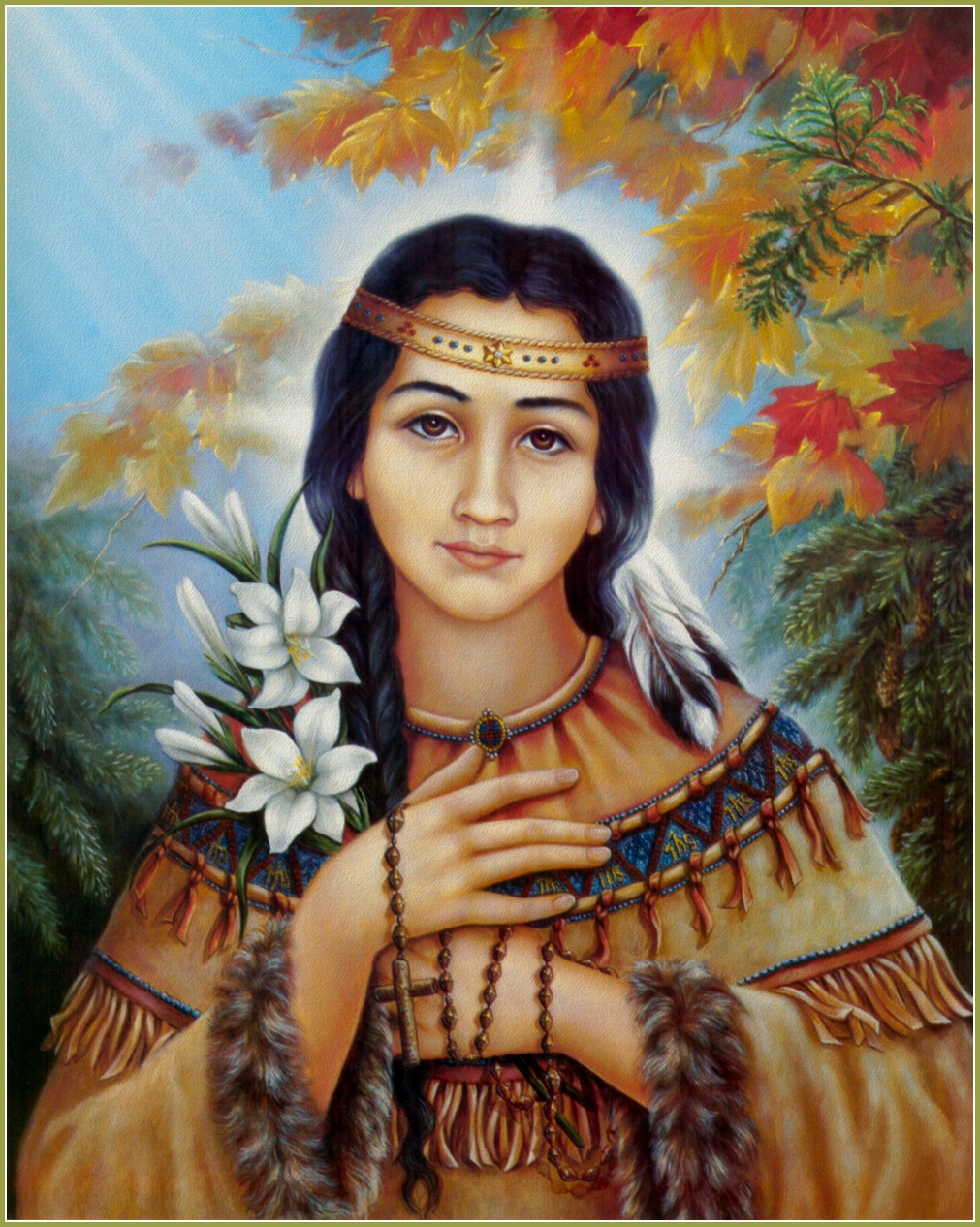Saint Kateri Tekakwitha
The Lily of the Mohawks

A Saint for Our Time
Saint Kateri Tekakwitha stands as a powerful figure of faith for our modern world. As the first Indigenous woman from North America to be named a saint, her life offers a way for us to understand and seek healing. She is a heavenly helper for the Church as it faces its history and works toward true reconciliation with Indigenous Peoples in Canada and beyond. Her story shows that the grace of Christ can bring forth great beauty and holiness, even from wounded ground.
Her Earthly Journey
1656: A World of Two Cultures
Kateri Tekakwitha was born in what is now Auriesville, New York. Her father was a Mohawk chief and her mother was a Catholic Algonquin woman. Her mother, Kahenta, secretly planted the first seeds of faith in Kateri's heart through hidden prayers and stories.
c. 1660: A Time of Great Sorrow
At just four years old, a smallpox epidemic took the lives of her parents and brother. Kateri survived, but the illness left her with scarred skin and weakened eyesight. This great suffering guided her gaze inward toward God, preparing her for a deep spiritual life.
1676: Answering the Call
Despite living with her uncle who opposed Christianity, Kateri felt a strong call to God. After receiving instruction from Jesuit missionaries, she was baptized on Easter Sunday in 1676. She took the name Kateri, in honour of Saint Catherine of Siena.
1677: A Journey for Faith
After her baptism, Kateri faced ridicule and threats in her village for her faith. To live her Catholic life freely, she made a difficult 320-kilometre journey on foot to a Christian Indigenous community in Kahnawake, near Montreal, where she could finally practise her faith in peace.
1677-1680: A Life Given to Christ
In Kahnawake, Kateri’s spiritual life flourished. She lived a life of intense prayer, cared for the sick and elderly, and in 1679, she made a vow of perpetual virginity, choosing Jesus as her only spouse. Her health, always frail, soon failed. She died during Holy Week in 1680 at age 24. Her last words were, "Jesus, I love you." Witnesses reported that in the moments after her death, the smallpox scars on her face vanished, revealing a serene beauty, a sign of her holiness.
The Path to Sainthood
The Miracle of Jake Finkbonner
For a person to be named a saint, the Church often requires proof of a miracle that happened through their intercession. For Kateri, this confirmation came in 2006. A five-year-old boy named Jake Finkbonner, a member of the Lummi Nation in Washington state, had a small cut that became infected with a life-threatening flesh-eating bacteria. When doctors had no hope for his survival, his family and community prayed intensely to Blessed Kateri. A relic of Kateri was placed on his body, and to the amazement of doctors, the infection stopped spreading.
Canonization
The Church carefully investigated Jake's healing and concluded it was medically inexplicable and a direct result of Kateri's intercession. On October 21, 2012, Pope Benedict XVI officially named Kateri Tekakwitha a saint of the universal Church. Hundreds of Indigenous people from Canada and the United States travelled to Rome to celebrate this historic moment.
A Bridge for Reconciliation in Canada
Protectress of Canada
Saint Kateri has been named the "Protectress of Canada." This title gives her a special role as a guardian who watches over the nation's spiritual well-being. She is also the patron saint of Indigenous Peoples, ecology, and people living in exile.
The Need for Healing
Understanding Saint Kateri's role requires facing a painful history. For over a century, the Canadian government's residential school system, largely operated by Christian churches, aimed to separate Indigenous children from their families, languages, and cultures. This system caused deep and lasting trauma. The Truth and Reconciliation Commission of Canada called this "cultural genocide" and set out 94 Calls to Action to help heal this legacy.
September 30th: A Day for Truth
September 30th is Canada’s National Day for Truth and Reconciliation. It is a day to honour the children who never returned from residential schools, to remember the Survivors, and to learn about this history. It is also known as Orange Shirt Day, a movement recognizing that "Every Child Matters."
Saint Kateri: A Model for a New Path
Saint Kateri's life is a powerful model for reconciliation. The residential school system was based on the false idea that to be Christian, one had to stop being Indigenous. Saint Kateri proves this wrong. She shows us that faith and culture can enrich each other. As Pope Benedict XVI said, her example helps us to "love Jesus without denying who we are." At a time when the Church is working to heal its relationship with Indigenous Peoples, God gave us a holy, powerful Indigenous intercessor. She is a bridge between peoples, guiding us toward a future of justice, peace, and true reconciliation.
